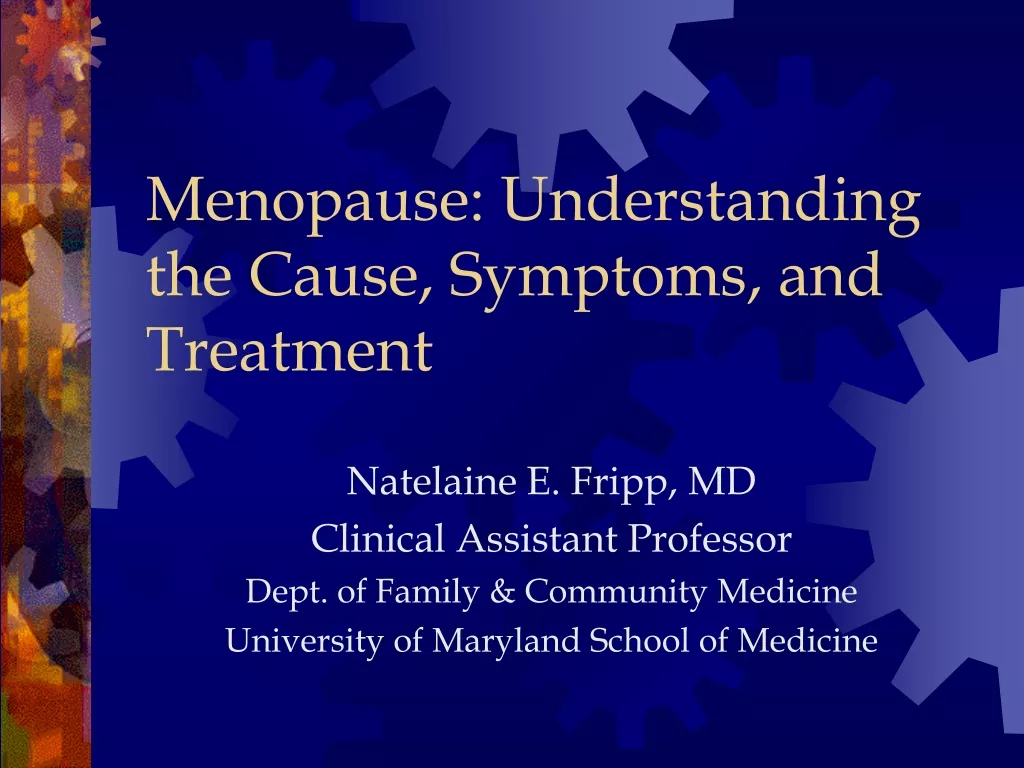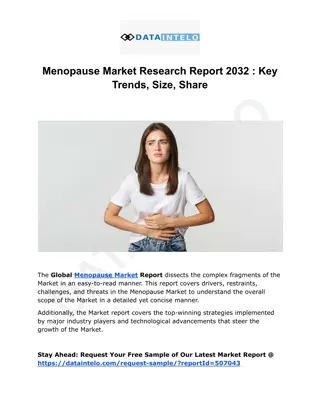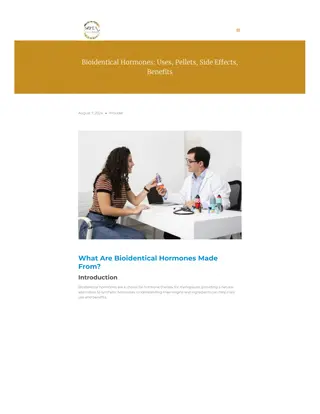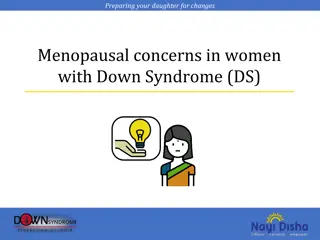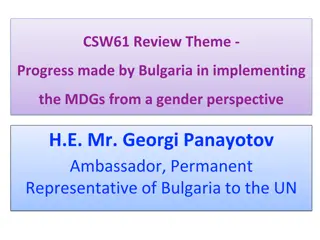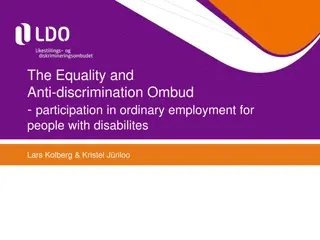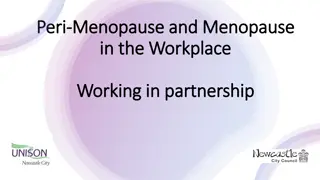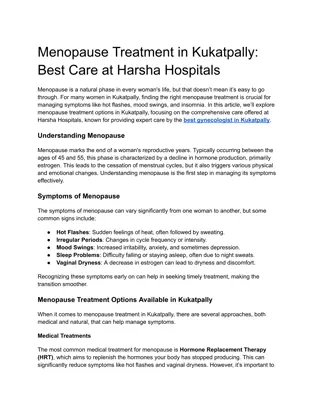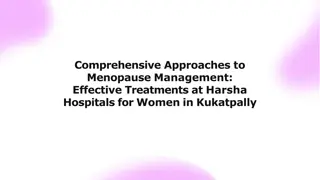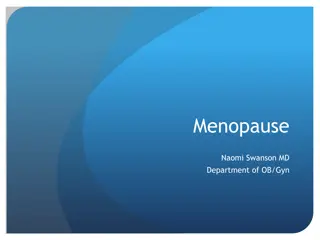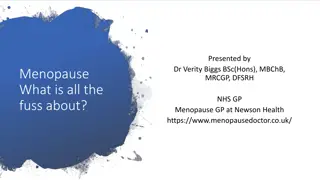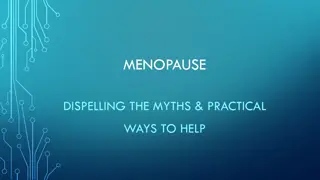Strengthening Equality Laws for Menopause Issues
Women experiencing discrimination during menopause need better legal protection. The National Federation of Women's Institutes resolution calls for menopause to be a recognized protected characteristic, similar to pregnancy and maternity, under the Equality Act 2010. This could help tackle stigma and improve workplace support for women going through menopause. The scale of the issue, current situation in the UK, and how the Women's Institute can work on this resolution are outlined.
Download Presentation

Please find below an Image/Link to download the presentation.
The content on the website is provided AS IS for your information and personal use only. It may not be sold, licensed, or shared on other websites without obtaining consent from the author.If you encounter any issues during the download, it is possible that the publisher has removed the file from their server.
You are allowed to download the files provided on this website for personal or commercial use, subject to the condition that they are used lawfully. All files are the property of their respective owners.
The content on the website is provided AS IS for your information and personal use only. It may not be sold, licensed, or shared on other websites without obtaining consent from the author.
E N D
Presentation Transcript
The Ever-changing Work Environment During COVID-19: Nurses Experiences During The Early Phase Julie McCulloh Nair PhD, RN, APHN-BC, CCRE Amanda Thomas BSN, RN
At the beginning of COVID-19: Crisis standards of care were implemented that led to constant change within the workplace. (HHS, 2020) Nurses had limited resources Clinical guidelines changed weekly Insufficient population health education left Nurses unprepared for the pandemic. (Veenema et al, 2020) This resulted in high anxiety, confusion and mistrust of respected organizations. (ANA, 2020) Nurses have an equal obligation to care for self and others. (ANA, n.d.) Introduction
Background Over the past century, nurses have served on the frontlines of several deadly pandemics, caring for the infected and dying patients. (Brand, 2016) During COVID-19 nurses continued to work despite the fears of infection and moral distress due to crises standards of care. Literature exists that reflect RNs willingness to serve, but very little exists that speaks to their experiences, perceptions and reaction to change rooted in crisis. (Stearns, 1998)
The purpose of this study is to explore nurses experiences during the early phase of the COVID-19 pandemic. Purpose and Significance Knowledge gained from nurses first-hand accounts and stories utilizing crisis standards of care during a pandemic is vital and may lead to new policies, preparedness education for future pandemics, and prevent repeating past mistakes.
Methods A phenomenological approach was employed in this qualitative study. This method allowed study investigators to explore nurses lived experiences using their own written descriptions and digital images. (Creswell & Poth, 2018; De Chesnay, 2015; Finlay, 2009) Participants were asked to provide their stories using both methods along with demographic information to assist with characterization of participants.
Methods Study investigators used their personal networks (nursing colleagues, friends, and family) to recruit nurses to participate in this study via personal email, text messaging, social media accounts and the Sigma website. A purposive sampling strategy was used to recruit approximately 25 participants nationwide. Sample and Setting: Using a snowball technique, study investigators asked participants to share the recruitment letter that contained a link to the COVID-19 Nursing Experience survey with their personal nursing network via email, text messaging and social media accounts. These strategies allowed for a deliberate selection of participants from all specialty areas within the nursing profession as this research focused exclusively on the nursing experience. To meet inclusion criteria, participants had to be registered nurses, retired nurses, or new graduate nurses, with all others were excluded from this study.
Data Collection occurred in the U.S. between late April to early June 2020, which was during the early phase of COVID-19. Methods The COVID-19 RN experience survey was delivered via Qualtrics and consisted of 3 sections: demographics, written narratives, digital images and/or video of story. All submissions were anonymous with the survey taking approximately 30 mins 1 hour to complete. All study investigators used the 6-step process (Braun & Clark, 2008) for thematic analysis to generate themes from the collected lived experience data. Study investigators met regularly for analysis sessions; trustworthiness of findings was assured due to similarities found among interpretations and bracketing was used to remove biases. Quantitative data analysis was completed in Qualtrics and SPSS statistical software independently of the qualitative data analysis which was completed in MAXQDA2020 software and Excel spreadsheets. By combining these methods, study investigators were able to identify the essence of the nursing experience during the early phases of the COVID-19 pandemic. (Creswell & Poth, 2018; Marshal & Rossman, 2016)
Results 161 nurses enrolled in this study 40% of the participants worked in critical care, medical/surgical or the emergency department Novice nurses (<5 years of experience) accounted for 42% of the participants 58 participants submitted narratives of their first-hand experiences during the early phase of this pandemic
Qualitative Results Everchanging Environment was the overarching theme that emerged from this study Six subthemes under this umbrella Innovation to practice Adapting to a new role Nurses fears and anxiety Job loss Lack of supplies Emotional distress
Qualitative Excerpts With every day came a new update. What we were being told to do just the day before wasn t evidence-based practice any longer. Within weeks, my floor was completely transitioned from a cardiac step-down to a COVID-19 unit. I had to forget everything I spent the last 6 months learning. All PPE supplies were removed from our supply rooms and are now stored in a central location under lock and key We are given one surgical and 1 n95 mask per week andhave to make them last. We have lived in a constant state of panic that we ll bring this home to our families and loved ones. We were basically told to throw out all we have learned about infection control and proper PPE and wing it. I feel trapped, and I feel like I m suffocating with no way out or no end on sight.
Discussion Nurses were affected by the ever-changing environment irrespective of age, experience, institution type or practice settings Adoption of crisis care standards resulted in rapidly changing environment with little infrastructure support Fear & anxiety related to redeployment, lack of supplies, training, and overall unpreparedness to provide safe and effective care Constant changes to practice and work environment led to emotional distress
Conclusion COVID-19 was unprecedented in its global reach and spread, and impacted nurses in all settings and specialty areas Adoption of crisis care standards caused significant and frequent changes to the work environment First-hand accounts illuminated the many gaps in public health emergency preparedness and response that require additional education, training and policy development.
Conclusion Cross-training nurses for redeployment to other settings should be considered to ensure patient safety and clinical competencies Access to mental health serves now and post-pandemic is highly recommended due to the high emotional distress experienced by nurses during this pandemic Acknowledgements - Special thanks to our study team members, Drs. Susan Birkhoff and Deborah Mandel. Final edits to the manuscript have been submitted in the Journal for Nurses in Professional Development.
Focus is needed on nursing workforce development and preparedness to respond to public health emergencies, in addition to nurses mental health outcomes Future Research Future studies should capture the nursing experience during different phases of the pandemic, to enable comparative analyses
References American Nurses Association (ANA) (n.d.). Provision 5: Self-care & COVID-19. https://www.nursingworld.org/~4a1fea/globalassets/covid19/provision-5_-self-care--covid19-final.pdf American Nurses Association (ANA) (2020, September). COVID-19: Evidence as the basis of decisions. https://www.nursingworld.org/~4a5b08/globalassets/covid19/covid-19_-evidence-as-the-basis-of-decisions-final_sm.pdf Brand, R. (2016, May, 1) 408 . Charting nursing s future: Reports that can inform policy and practice. Robert Wood Johnson Foundation. https://www.rwjf.org/content/dam/farm/reports/issue_briefs/2016/rwjf429036 Creswell, J. & Poth, C. (201 431 8). Qualitative inquiry & research design: Choosing among five approaches (4th ed.). Sage. De Chesnay, M. (2015). Nursing research using phenomenology: Qualitative designs and methods in nursing. Springer. Finlay, L. (2009). Debating phenomenological research methods. Phenomenology and Practice, 3(1), 6-25. Stearns, P. (1998). Why study history? American Historical Association. https://www.historians.org/about-aha-and- membership/aha-history-and-archives/historical-archives/why-study-history-(1998) U.S. Department of Health & Human Services (HHS) (2020). COVID-19 patient surge and scarce resource allocation. https://asprtracie.hhs.gov/covid-19-patient-surge Veenema, T. G., Meyer, D., Bell, S. A., Couig, M. P., Friese, C. R., Lavin, R., Stanley, J., Martin, E., Montague, M., Toner, E., Schoch-Spana, M., Cicero, A., & Inglesby, T., (2020, June). Recommendations for improving national nurse preparedness for pandemic response: Early lesson from COVID-19. Johns Hopkins Center for Health Security. https://www.centerforhealthsecurity.org/our-work/publications/recommendations-for-improving-national-nurse- preparedness-for-pandemic-response--early-lessons-from-covid-19


